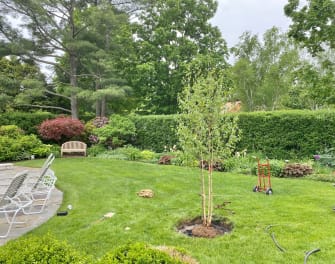I spoke at a local Homeowners Association meeting recently and I started off by discussing landscape maintenance. Economically, it's said that a healthy landscape is equivalent to about 20% of any property's value - this bit of information seemed to get everyone's attention.

After some worthwhile conversation, the discussion eventually turned to the topic of many homeowners being disappointed by contractors. Honestly, I was alarmed by some of the things I heard. With Spring approaching I thought it would be a perfect time to highlight some of the common mistakes we see in landscapes. I'm hopeful this saves you some frustration but, as always, if you have any questions or concerns about your landscape we welcome you to stop in and visit us. We're always happy to help however we can.
- Mulch is applied to help with soil conditions, it's not meant to help the trunk of trees and it should be kept away from the base of plants. Do not use mulch as a weed deterrent. It requires way too much mulch and it gradually suffocates the plants after years of accumulating. If you have plants struggling in the garden, pull the mulch back away from the base. This is the first thing I do everytime I inspect a garden.
- Mulch should be applied 2-3" and not be placed against the base of the plants. Landscapers make a lot of money installing mulch. It may behoove you to cut the amount of mulch in half for now. Just use enough to make the gardens look attractive. This should reduce your costs and not compromise any plant material. It's more likely to help the plants by doing less.
- All those beautiful "green blotches" on your trees and shrubs are called Lichen. Lichen is a saprophitic organism that survives on plants. It's not a disease or pest. Do not let a contractor convince you to part with your money to treat Lichen. If you have Lichen on your plants, it's a good thing. It means you're breathing clean air. Lichen rarely grows in an urban setting and, perhaps, you'll come to appreciate the natural appearance.
- Ivy growing on plants does not harm the plants; however it should be managed. English Ivy in particular can compromise shrubs by engulfing them. They do compete for moisture and nutrients however they can coexist perfectly. Do not let a tree contractor convince you to remove a tree because ivy is growing on the trunk. I often recommend cutting the ivy at the base and letting it slough off over a season. It's always better to see the trunk of your trees to make sure they're safe. My recommendation is to not plant English Ivy. Pachysandra or Ajuga are lovely substitutes.
- If you're planning to meet with a tree company, please beware! The industry that fed me and inspired me to open Decker's Nursery has changed - and not for the better. I'm becoming very concerned about the amount of tree destruction that occurs on Long Island. Driving around I see (and hear) all the tree care companies because of their equipment. Do not allow a company to scare you into destroying a tree. We should be preserving trees and investing in the care of your mature trees to keep them safe and healthy. Pruning dead branches, elevating low limbs, thinning to reduce the sail effect will provide invaluable benefits. Even consider fertilizing your mature trees.
- This was an additional tip that came to mind as I was writing but it's just as important as the others. Please, do not "Top" your trees. Topping trees is when the upper canopy is removed which leaves the trees looking like a "hat rack". Topping is really just another form of destruction that removes the integrity and character of trees. Topping your trees is a poor decision and it will never be recommended by a reputable tree care company.
